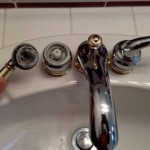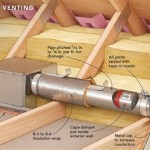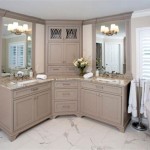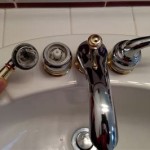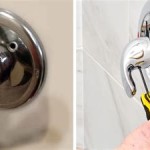Addressing the Gap Between Bathroom Vanity and Side Wall
The installation of a bathroom vanity frequently involves encountering a gap between the vanity's side edge and the adjacent wall. This space, seemingly minor, can present a variety of challenges, affecting the aesthetic appeal, hygiene, and structural integrity of the bathroom. Understanding the causes, consequences, and solutions related to this gap is crucial for both professional installers and homeowners undertaking renovation projects.
Several factors can contribute to the formation of a gap between a bathroom vanity and the side wall. These factors can be broadly categorized as structural imperfections, dimensional discrepancies, and installation inaccuracies. Addressing these underlying causes is essential for achieving a seamless and functional bathroom design.
Understanding the Causes of the Gap
One of the primary reasons for a gap is the presence of uneven walls. Walls in older homes, in particular, are often not perfectly plumb or square. This can be due to settling, shifting foundations, or simply imperfect construction practices during the initial building phase. Even in newer construction, minor deviations from perfect vertical alignment can occur. When a perfectly rectangular vanity is placed against an imperfect wall, a gap is inevitable. The degree of the gap will depend on the severity of the wall imperfection.
Dimensional discrepancies between the vanity and the available space also contribute to the issue. Manufacturers often provide dimensions that are nominal, meaning they represent the expected size but may not be exact. Variations of a quarter inch or more can easily occur. Furthermore, if the space allocated for the vanity is not precisely measured before purchase, the vanity might be slightly too small, resulting in a gap. This issue is particularly pronounced when dealing with custom-built vanities, where precise measurements are even more critical. Minor errors during the fabrication process can lead to size discrepancies that manifest as gaps during installation.
Finally, inaccurate installation techniques can exacerbate the problem. Even with a perfectly sized vanity and relatively straight walls, improper installation can create or widen existing gaps. For example, failing to properly shim the vanity to ensure it is level and square can cause it to lean or twist slightly, increasing the space between the vanity and the wall. Rushing the installation process and neglecting to double-check measurements and alignments can also lead to noticeable gaps. Moreover, the type of flooring can also affect the perceived gap. If the flooring is uneven or slopes towards the wall, it can create an optical illusion, making the gap appear larger than it actually is.
Consequences of Leaving the Gap Unaddressed
An unaddressed gap between the bathroom vanity and the side wall can lead to several undesirable consequences. These consequences can range from aesthetic imperfections to potential health hazards and structural damage. Therefore, it is crucial to address these gaps promptly and effectively.
Aesthetically, a visible gap detracts from the overall appearance of the bathroom. It creates a jarring visual discontinuity that can make the entire space look unfinished or poorly maintained. This is particularly noticeable in bathrooms with a modern or minimalist design aesthetic, where clean lines and seamless transitions are highly valued. The gap can also highlight any imperfections in the wall itself, further diminishing the aesthetic appeal of the bathroom.
More seriously, the gap can become a breeding ground for mold and mildew. Water and moisture can easily seep into the space, especially during showering or cleaning. The dark, enclosed environment between the vanity and the wall provides ideal conditions for microbial growth. Mold and mildew not only produce unpleasant odors and unsightly stains but can also pose significant health risks, particularly for individuals with allergies or respiratory sensitivities. Prolonged exposure to mold spores can trigger allergic reactions, asthma attacks, and other respiratory problems.
The gap can also serve as a collection point for dirt, dust, and debris. These particles can accumulate over time, creating an unhygienic environment. Cleaning becomes difficult and time-consuming, as the narrow space is often inaccessible to conventional cleaning tools. This accumulation of debris can also attract pests, such as insects and rodents, which can further compromise the hygiene of the bathroom. Over time, the accumulated dirt and debris can also stain the wall and the vanity, making it even more difficult to clean.
Furthermore, a substantial gap can compromise the structural integrity of the vanity. If the gap is large enough, it can allow the vanity to shift or wobble, especially if it is not securely anchored to the wall. This can put stress on the vanity's joints and connections, potentially leading to cracks, breaks, or even complete failure. Over time, this structural weakness can necessitate costly repairs or even replacement of the entire vanity.
Practical Solutions for Addressing the Gap
Several methods can be employed to effectively address the gap between a bathroom vanity and the side wall. The choice of method depends on the size of the gap, the aesthetic preferences of the homeowner, and the overall design of the bathroom. Some solutions are simple and straightforward, while others require more specialized skills and tools.
For small gaps, typically less than a quarter of an inch, caulking is often the most practical and cost-effective solution. Caulk is a flexible sealant that can be applied to the gap to create a waterproof and airtight barrier. It is available in a variety of colors to match the vanity or wall, allowing for a seamless and unobtrusive finish. When applying caulk, it is important to clean the surfaces thoroughly and use a high-quality caulk specifically designed for bathroom use. A smooth and consistent bead of caulk can be achieved using a caulking gun and a wet finger or a specialized smoothing tool. Regular inspection and reapplication of caulk may be necessary, as it can shrink or crack over time.
For larger gaps, exceeding a quarter of an inch, a backer rod should be used in conjunction with caulk. A backer rod is a flexible foam cord that is inserted into the gap before applying the caulk. It provides a solid backing for the caulk, preventing it from sinking too deep and ensuring a proper seal. The backer rod also helps to reduce the amount of caulk needed, saving both time and material. When selecting a backer rod, it is important to choose one that is slightly larger than the gap to ensure a snug fit. The caulk is then applied over the backer rod in the same manner as described above.
In situations where the gap is exceptionally large or uneven, or when a more permanent and structurally sound solution is desired, installing a filler strip or scribe molding is a viable option. A filler strip is a thin piece of wood or other material that is cut to match the shape of the gap. It is then glued or screwed to the vanity, effectively extending its side to meet the wall. Scribe molding is similar to a filler strip but has a decorative profile that adds visual interest. When installing a filler strip or scribe molding, it is important to prime and paint or stain it to match the vanity. This ensures a cohesive and professional-looking finish. Furthermore, the strip should be carefully scribed (cut) to conform to any irregularities in the wall, creating a seamless joint.
For more complex installation problems, especially when dealing with significantly uneven walls, it may be necessary to consult with a professional contractor. A contractor can assess the situation and recommend the most appropriate solution. This might involve adjusting the wall itself, modifying the vanity, or employing a combination of techniques to achieve a satisfactory result. Addressing underlying structural issues, such as re-framing a section of the wall, may be necessary to ensure a long-term solution. While this approach can be more expensive, it can prevent future problems and ensure the structural integrity of the bathroom.

4 Ways To Fix A Gap Between Vanity And Wall

Big Gap Between Vanity And Wall

4 Ways To Fix A Gap Between Vanity And Wall

How To Fill Gap Between Vanity And Wall 7 Solutions

Bathroom Vanity Between Two Walls Just In Place Renovation
Gap Between Wall And Bathroom Vanity Wondering If I Can Tile Ceramic Advice Forums John Bridge

The Question Of Vanity View Along Way

Alcove Vanity Flush To Walls Or Ok Have Space On Sides

How To Fill The Gap Between Vanity And Wall A Detailed Guide Funktional Home

How To Fill A Gap Between Vanity And Side Wall Baseboard Issue Too
Related Posts
